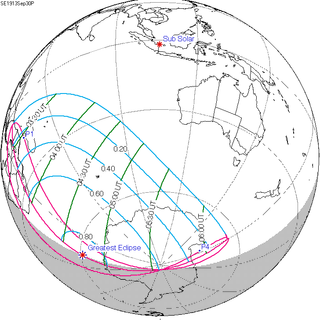Solar eclipse of September 30, 1913
Appearance
| Solar eclipse of September 30, 1913 | |
|---|---|
| Type of eclipse | |
| Nature | Partial |
| Gamma | −1.1005 |
| Magnitude | 0.8252 |
| Maximum eclipse | |
| Coordinates | 61°00′S11°36′E/ 61°S 11.6°E |
| Times (UTC) | |
| Greatest eclipse | 4:45:49 |
| References | |
| Saros | 152(7 of 70) |
| Catalog # (SE5000) | 9311 |
A partialsolar eclipseoccurred on Tuesday, September 30, 1913.[1][2][3][4]Asolar eclipseoccurs when theMoonpasses betweenEarthand theSun,thereby totally or partly obscuring the image of the Sun for a viewer on Earth. A partial solar eclipse occurs in the polar regions of the Earth when the center of the Moon's shadow misses the Earth.
Related eclipses[edit]
Solar eclipses 1910–1913[edit]
This eclipse is a member of asemester series.An eclipse in a semester series of solar eclipses repeats approximately every 177 days and 4 hours (a semester) at alternatingnodesof the Moon's orbit.[5]
| Solar eclipseseries sets from 1910 to 1913 | ||||
|---|---|---|---|---|
| Ascending node | Descending node | |||
| 117 | May 9, 1910 Total |
122 | November 2, 1910 Partial | |
| 127 | April 28, 1911 Total |
132 | October 22, 1911 Annular | |
| 137 | April 17, 1912 Hybrid |
142 | October 10, 1912 Total | |
| 147 | April 6, 1913 Partial |
152 | September 30, 1913 Partial | |
References[edit]
- ^"The heavens in September".The Commercial Appeal.Memphis, Tennessee. 1913-08-31. p. 51.Retrieved2023-11-04– via Newspapers.com.
- ^"THE HEAVENS IN SEPTEMBER".The Times-Democrat.New Orleans, Louisiana. 1913-08-31. p. 29.Retrieved2023-11-04– via Newspapers.com.
- ^"An enterprising hawker".Cambridge Evening News.Cambridge, Cambridgeshire, England. 1913-09-30. p. 3.Retrieved2023-11-04– via Newspapers.com.
- ^"ECLIPSE OF THE SUN".Western Mail.Cardiff, South Glamorgan, Wales. 1913-09-30. p. 8.Retrieved2023-11-04– via Newspapers.com.
- ^van Gent, R.H."Solar- and Lunar-Eclipse Predictions from Antiquity to the Present".A Catalogue of Eclipse Cycles.Utrecht University.Retrieved6 October2018.
External links[edit]
- Earth visibility chart and eclipse statisticsEclipse Predictions byFred Espenak,NASA/GSFC




